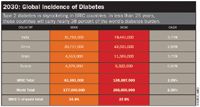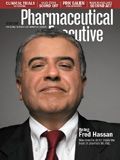Hits Like a BRIC
Pharmaceutical Executive
The first wealth is health, wrote American thinker Ralph Waldo Emerson. Indeed, history has taught us (even before Emerson) that health and wealth are inextricably linked-the more money one has, the healthier one is likely to be.
The first wealth is health, wrote American thinker Ralph Waldo Emerson. Indeed, history has taught us (even before Emerson) that health and wealth are inextricably linked—the more money one has, the healthier one is likely to be.

Charles Conrad Uy
But the economic gains and growing wealth of the middle classes in countries like Brazil, Russia, India, and China (BRIC) don't seem to fit into that equation. A growing body of research shows that, in these countries, economic gains don't translate evenly into health benefits. Rather, the rapid confluence of industrialization, increased economic wealth, and shifting demography means that these emerging countries' disease burden isn't going away—it's just changing.

Gerhard Symons
Consider this: From 2005 to 2030, improvements in sanitation, pediatric care, and the treatment of communicable diseases will increase projected life expectancy by about four years in Brazil, Russia, and China, and seven years in India. On the other hand, the impact of chronic diseases—such as cardiovascular disease, cancer, respiratory disease, and type 2 diabetes, which are more commonly associated with wealthier developed nations—is already taking its toll. The World Health Organization (WHO) now estimates that 80 percent of global mortality due to chronic disease occurs in low- and middle-income countries. In Russia, for example, more than half (51.8 percent) of total deaths in 2002 are from cardiovascular and cerebrovascular disease, according to the European Health Report 2005.
However, of all the chronic diseases that are on the rise in BRIC, diabetes may be considered the most pernicious. WHO has outlined a three-step framework for governments to help reduce the burden of diabetes. Yet given both the commercial and public health opportunities, the question remains, what role can the pharmaceutical industry play?
Diabetes Rising—Opportunities and Challenges
In 2000, Brazil, Russia, India, and China alone accounted for 34.8 percent of the total global prevalence of diabetes. According to WHO, BRIC's share of the global diabetes burden is set to increase to 37.8 percent by 2030. Though a three-percentage-point increase may not sound like a lot, it translates to a more than doubling of BRIC's diabetic population, from 61.5 million patients to 138 million patients.

2030: Global Incidence of Diabetes
These markets are ripe for investment—personal income is on the rise, and it's expected to spur utilization of drugs. In Russia, wages tripled from 2001 to 2006, and the introduction of $1.35 billion in public money for the reimbursement of medicines has helped to create a $9 billion pharmaceutical market. In India, the drug market is expected to grow 12 percent year on year from 2005 to 2009, according to WHO. China's market for healthcare services is also expected to skyrocket, with drug sales set to exceed $46 billion by 2010, according to Business Monitor's China Pharmaceuticals Report.
While the patients are there, the issue for pharma companies is that the BRIC diabetes markets are not well formed. In developed countries, there are armamentariums of medical technology, frequently updated clinical guidelines, and innovative therapies that can screen, diagnose, and adequately treat the symptoms and sequelae of diabetes. But in BRIC countries, there is a lack of disease awareness and access to screening. Half of all type 2 diabetes patients in India remain undiagnosed, according to the International Diabetes Federation. Part of the problem is that the majority of patients must visit specialist pathology laboratories to access disease-monitoring tests, and the costs to do that may be prohibitive. What's more, compliance remains a core challenge in the treatment of diabetes, with only 2 percent of patients in India owning a meter for blood glucose self-testing, according to Stefan Björk, Novo Nordisk's senior adviser of corporate stakeholders.

Aging Population, Different Diseases
This lack of awareness of innovative therapies and the costs of the therapy, rather than the appropriateness of the therapy, drives prescribing decisions. Therefore, BRIC physicians favor traditional or generic therapies—including insulin injection. Indirectly, this contributes to stigma for diabetes patients, who may wrongly perceive that injectable medicines are addictive. For this reason, and because of needle phobia (which is stronger in the BRIC countries because of inadequate patient education), half of diabetes patients in China visit healthcare professionals for injections.
Given these issues, the challenge of tackling type 2 diabetes in BRIC countries may seem overwhelming. In Brazil, Russia, India, and China, there are more than 5 million healthcare professionals, over 50 official languages, and taken together, hundreds of millions of patients. Pharma firms must also consider logistics, given that selling drugs within these countries means disseminating therapies across 25 percent of the planet's land mass. On top of that, healthcare systems are unwieldy, inconsistent in quality, and underfunded; data from World Bank shows that China and India have less than three physicians per 1,000 people, while Russia's 12.5 health workers per 1,000 are concentrated in a highly inefficient secondary-care system.
The industry has already seen how intellectual-property challenges from generics competitors and governments are serious barriers to business, as are opaque regulatory and formulary practices. The few institutional checks through BRIC countries' procurement and prescribing chains often breed corruption, counterfeiting, and disregard for legal procedures. This means that Western pharmaceutical companies don't operate in a transparent market within BRIC, and, ultimately, patients lose out due to a lack of enforced standards in drug safety, quality, and efficacy. More than half of Russia's total healthcare expenditure, for example, is in informal and out-of-pocket payments, according to the 2006 Global Corruption Report by Transparency International.
What is Pharma's Role?
Despite the big and still-growing problem of diabetes, only five of the top-20 pharma companies have diabetes projects in clinical trials, according to ClinicalStudyResults.org. This may mean that, for Big Pharma, commercial success in treating diabetes is not due to innovative R&D alone, but due to innovative marketing execution.
Indeed, a recent initiative underscores that point. At the 19th World Diabetes Congress in Cape Town, South Africa, Lilly announced that it had underwritten an International Diabetes Federation grant for $10 million to fund translational diabetes research to find cost-effective and sustainable solutions to improve diabetes outcomes in developing nations. This action reflects Lilly's recognition that new medical-intervention practices are needed to manage the treatment of diabetic populations in the developing world.
But given the range of issues that come under the umbrella of marketing—from awareness to pricing to logistics and beyond—pharma companies' success in BRIC countries may depend on how well they can partner. By committing to long-term relationships with local partners and governments, pharmaceutical firms can undertake a range of activities that support sales and marketing efforts, and gain insights from customers and stakeholders by taking a lead in public-health issues.
At the outset, pharma companies may decide to develop ventures with local NGOs or with government organizations. The chief benefit of this is the insight gained by working with the variety of people and agencies involved in diabetes management regionally or nationally. For example, as part of the World Partner Project initiative, Novo Nordisk established an integrated diabetes-management system in six major cities in China by collaborating with China's Ministry of Health and the Chinese Diabetes Society. In India, the World Diabetes Foundation has funded many projects—ranging from diabetes prevention to managing diabetic retinopathy—by collaborating with health professionals, third parties, and state governments.
Through dialogue with governments, industry associations may negotiate lower drug-import tariffs and increases in mandated profit limits or lobby for enforced intellectual-property rights. For example, the Association of International Pharmaceutical Manufacturers met with the Russian government in July 2007 to negotiate debt repayments, owed by the Federal Fund for Medical Insurance to member pharma firms.
In the end, the movement of the industry toward treating BRIC countries' chronic-disease burden will help enable these markets to grow—which will help both the health of the nations and the health of the industry.
Charles Conrad Uy is a Shell Centenary Scholar at the University of Cambridge and a consultant at the Mott MacDonald Group in London. He can be reached at conrad.uy@mottmac.com
Gerhard Symons is a doctoral researcher at the Centre for Health Management, Tanaka Business School, Imperial College London. He can be reached at g.symons@imperial.ac.uk
